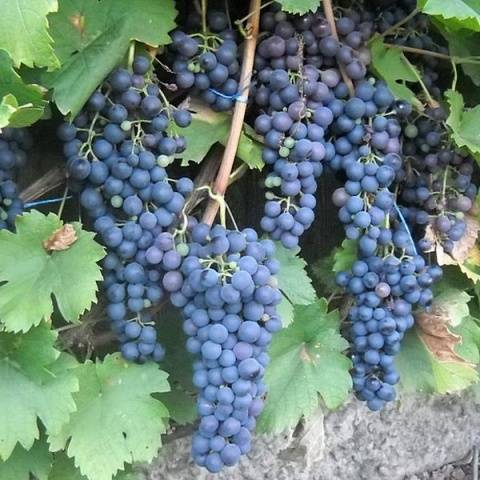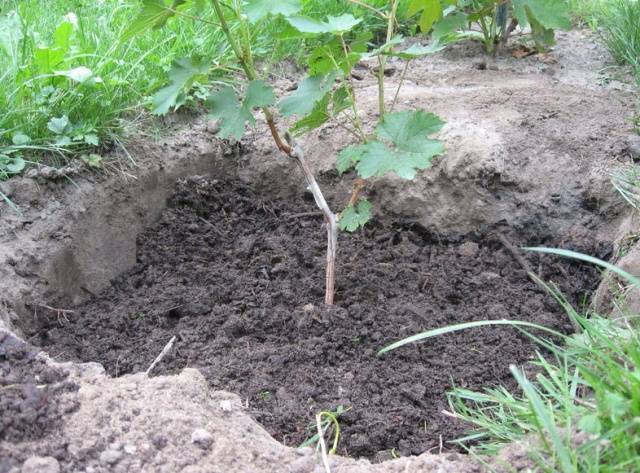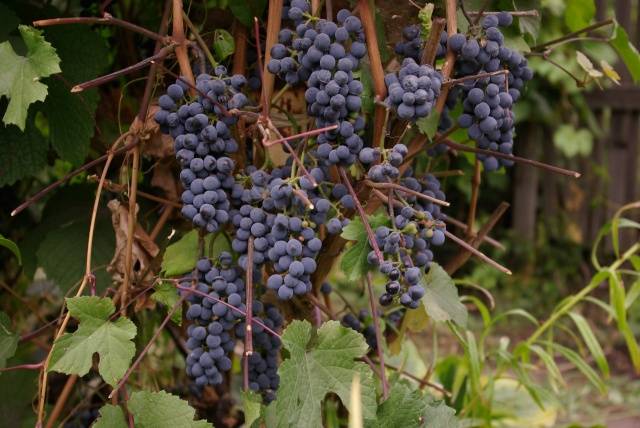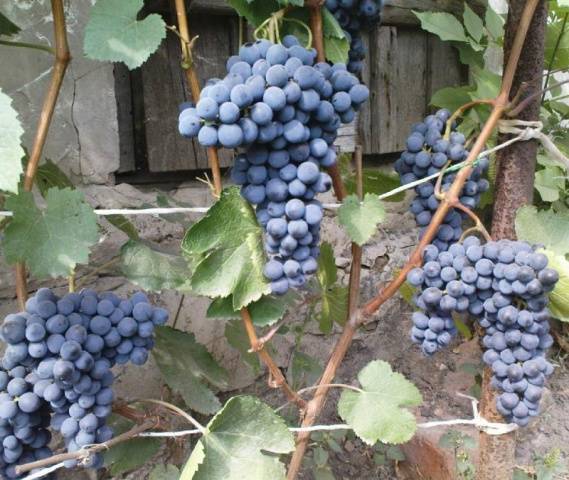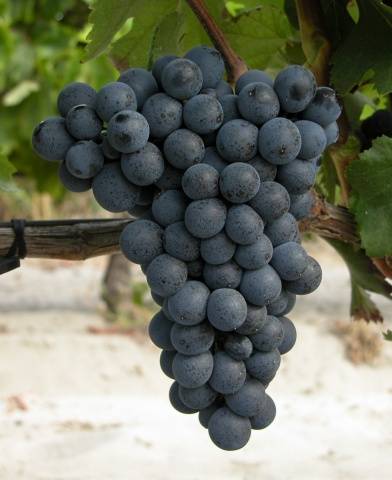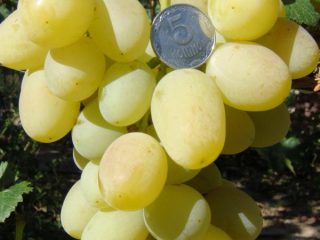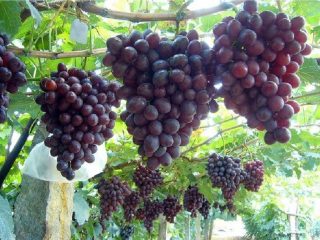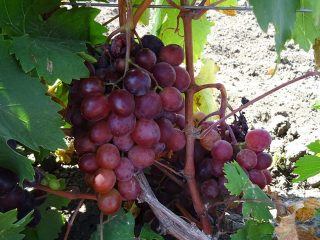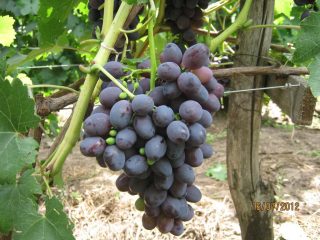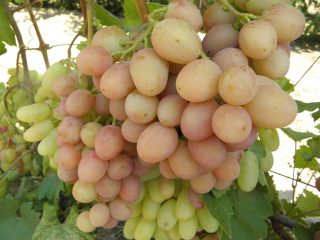Content
The Saperavi North grape is grown for wine or fresh consumption. The variety is characterized by increased winter hardiness and high yield. Plants endure harsh winters without shelter.
Characteristics of the variety
The Saperavi grape is an old Georgian variety, known since the 17th century. The grape got its name due to the increased concentration of dyes in the fruit. The variety was used to color wines from white and red grape varieties.
In the garden plots, the northern Saperavi variety is grown, which has increased winter hardiness. The variety has been approved for cultivation since 1958 in the North Caucasus and the Volga region.
According to the description of the variety, photos and reviews, the Saperavi North grape has a number of features:
- technical grade;
- medium late ripening;
- growing season 140-145 days;
- medium-sized rounded leaves;
- bisexual flowers;
- bunch weight from 100 to 200 g;
- the conical shape of the bunch.
Characteristics of Saperavi berries:
- weight from 0.7 to 1.2 g;
- oval shape;
- dark blue firm skin;
- wax bloom;
- juicy pulp;
- dark pink juice;
- the number of seeds is from 2 to 5;
- simple harmonious taste.
The drought resistance of the variety is assessed as medium. Flowers rarely fall off, berries are not prone to pea.
The crop is harvested at the end of September. Fruiting is high and stable. With late harvesting, the berries are shedding.
The Saperavi Severny variety is used for the preparation of table and blended juices. Saperavi wine is characterized by increased astringency.
Saperavi grapes in the photo:
Planting grapes
Saperavi grapes are planted in the autumn so that the plants have time to take root and prepare for winter. Seedlings are purchased from trusted suppliers. A place for growing a culture is preliminarily prepared. Light exposure, wind protection and soil quality must be taken into account.
Preparatory stage
Grape planting works have been carried out since the beginning of October. The latest date for planting the Saperavi variety is 10 days before the onset of frost. Autumn planting preferable to spring, since the development of the root system occurs. If you need to plant grapes in spring, then choose the period from mid-May to early June.
Saperavi seedlings are purchased in nurseries or from trusted producers. It is best to choose an annual shoot up to 0.5 m high and 8 cm in diameter. Healthy seedlings have green branches and white roots. Ripe buds should be on the shoots.
Plants are planted on the south, southwest or west side of the site. If the beds are located on a slope, then the planting holes are prepared in the central part. When located in the lowlands, the grapes freeze and are exposed to moisture. The permissible distance to trees is 5 m.
Work order
The North Saperavi grapes are planted in prepared pits. When carrying out planting work, fertilizers are necessarily applied to the soil.
Grape seedlings also need preparation. Their roots are placed in clean water for a day. The shoots are shortened and 4 eyes are left, the root system is slightly pruned.
Photo of Saperavi grapes after planting:
Sequence of planting Saperavi grapes:
- First, they dig a hole up to 1 m in diameter.
- A layer of rubble 10 cm thick is placed on the bottom.
- At a distance of 10 cm from the edge of the planting pit, a pipe with a diameter of 5 cm is placed.Above the surface of the ground, 15 cm of the pipe should remain.
- A layer of chernozem soil 15 cm thick is poured onto the crushed stone.
- From fertilizers, 150 g of potassium salt and 200 g of superphosphate are used. You can replace minerals with wood ash.
- Fertilizers are covered with fertile soil, then mineral substances are again poured.
- The soil is poured into the pit, which is tamped. Then 5 buckets of water are poured.
- The planting hole is left for 1-2 months, after which a small mound of the ground is poured.
- A Saperavi grape seedling is placed on top, its roots are straightened and covered with soil.
- After compacting the soil, water the plant abundantly and cover the soil with plastic wrap, after cutting out a hole for the pipe and seedling.
- The grapes are covered with a cut plastic bottle.
The plant is watered through an abandoned pipe. When the grapes take root, the film and the bottle are removed.
Variety care
The Saperavi North grape variety produces a good harvest with regular care. The plantings are fed during the season, periodically watered. Be sure to perform preventive pruning of shoots. Special means are used to protect against diseases. In cold regions, the Saperavi variety is sheltered for the winter.
The Saperavi variety is characterized by an average resistance to diseases. The variety is not very susceptible to gray rot and mildew. When using high-quality planting material and following the rules of growing, plants rarely get sick.
Watering
The Saperavi grapes are watered after the snow melts and the covering material is removed. Plants under 3 years old are watered using dug-in pipes.
In the future, moisture is applied twice - a week before the opening of the buds and after the end of flowering. When the Saperavi berries begin to turn blue, watering is stopped.
In late autumn, before the shelter for the winter, the grapes are watered abundantly. The introduction of moisture helps the plants to cope with the winter better. If the Saperavi variety is grown for winemaking, then one sub-winter watering per season is enough for the plants.
Top dressing
Saperavi grapes respond positively to the introduction of minerals and organics. When using fertilizers during planting, the plants are not fed for 3-4 years. During this period, a bush is formed and fruiting begins.
The first treatment is carried out after removing the shelter in the spring. Each plant needs 50 g of urea, 40 g of superphosphate and 30 g of potassium sulfate. Substances are introduced into the furrows made around the bushes and covered with earth.
A week before flowering, the grapes are fed with chicken droppings. Add 2 buckets of water to 1 bucket of fertilizer. The product is left to infuse for 10 days, then diluted with water in a ratio of 1: 5. 20 g of potassium and phosphorus fertilizers are added to the solution.
Nitrogen supplements, including chicken droppings, are used until mid-summer. Nitrogen stimulates the formation of shoots, which negatively affects the yield.
When the berries ripen, the plants are watered with a solution containing 45 g of phosphorus and 15 g of potassium substance. Fertilizers can be embedded in the soil dry.
The Saperavi North grapes are processed by spraying. For processing, they take Kemir or Aquarin preparations containing a complex of nutrients.
Pruning
Saperavi grapes are pruned in the fall, when the growing season is over. Pruning allows you to rejuvenate the bush, increase its life and yield. In the spring, only sanitary pruning is performed if there are diseased or frozen shoots.
On young plants, 3-8 sleeves are left. In adult bushes, young shoots up to 50 cm long are eliminated. On branches more than 80 cm long, lateral stepchildren are removed and the tops are shortened by 10%.
In the summer, it is enough to remove unnecessary shoots and leaves that cover the bunches from the sun. The procedure allows the plant to receive uniform lighting and nutrition.
Shelter for the winter
The Saperavi Severny variety is resistant to winter frosts. In the absence of snow cover, plants need additional cover.
The grapes are removed from the lashes and covered with spruce branches. Arches are placed on top, on which agrofibre is pulled. The edges of the covering material are pressed down with stones. The hiding place shouldn't be too tight. Fresh air is provided to the grapes.
Gardeners reviews
Conclusion
The Saperavi Severny grape is a technical variety used to make wine. The plant is characterized by increased resistance to winter frosts, high and stable yield. The culture is grown in prepared areas, watered and fed. Preventive pruning is performed in the fall. The Saperavi variety is unpretentious and rarely suffers from diseases.
